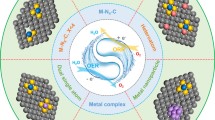Abstract
M-N-C electrocatalysts (where M is Fe or Co) have been investigated for mitigating the dependence on noble metals when catalyzing the oxygen reduction reaction (ORR) for fuel cell technologies in acidic or alkaline conditions. Rotating disk and rotating ring-disk electrode measurements for Fe-N-C and Co-N-C catalysts demonstrate promising performances and stability for the ORR, while the activity of main suspected active sites (M-NxCy and M@N-C) has been discussed on the basis of the known physical-chemical properties of the catalysts in acid and alkaline media. Thereupon, it is observed that atomically dispersed Fe-NxCy sites reach the highest ORR activity in acid media when amplified by an adequate energy binding between the metallic center and the oxygenated reaction intermediates. In contrast, Fe@N-C core-shell sites reach a maximum ORR mass activity in alkaline media through a synergistic effect involving catalyst particles with metallic iron in the core and nitrogen-doped carbon in the shell.

.
Graphical Abstract






Similar content being viewed by others
References
Shao M, Chang Q, Dodelet J-P, Chenitz R (2016) Recent advances in electrocatalysts for oxygen reduction reaction. Chem Rev 116(6):3594–3657
Lopes T, Kucernak A, Malko D, Ticianelli EA (2016) Mechanistic insights into the oxygen reduction reaction on metal–N–C electrocatalysts under fuel cell conditions. ChemElectroChem 3:1580–1590
Gasteiger HA, Kocha SS, Sompalli B, Wagner FT (2005) Activity benchmarks and requirements for Pt, Pt-alloy, and non-Pt oxygen reduction catalysts for PEMFCs. Appl Catal B Environ 56:9–35
Serov A, Zenyuk IV, Arges CG, Chatenet M (2018) Hot topics in alkaline exchange membrane fuel cells. J Power Sources 375:149–157
Li J, Alsudairi A, Ma ZF, Mukerjee S, Jia Q (2017) Asymmetric volcano trend in oxygen reduction activity of Pt and non-Pt catalysts: in situ identification of the site-blocking effect. J Am Chem Soc 139(4):1384–1387
Strateg Anal Inc. Mass Production Cost Estimation of Direct H2 PEM Fuel Cell Systems for Transportation Applications : 2013 Update (2013) US Department of Energy, Washington. https://www.energy.gov/sites/prod/files/2014/11/f19/fcto_sa_2013_pemfc_transportation_cost_analysis.pdf .
Li J, Ghoshal S, Liang W et al (2016) Structural and mechanistic basis for the high activity of Fe-N-C catalysts toward oxygen reduction. Energy Environ Sci 9:2418–2432
do Rêgo UA, Lopes T, Bott-Neto JL et al (2019) Non-noble Fe-Nx/C electrocatalysts on tungsten carbides/N-doped carbons for the oxygen reduction reaction. Electrocatalysis 10:134–148
do Rêgo UA, Lopes T, Bott-Neto JL et al (2018) Oxygen reduction electrocatalysis on transition metal-nitrogen modified tungsten carbide nanomaterials. J Electroanal Chem 810:222–231
Zhong G, Wang H, Yu H, Peng F (2015) Nitrogen doped carbon nanotubes with encapsulated ferric carbide as excellent electrocatalyst for oxygen reduction reaction in acid and alkaline media. J Power Sources 286:495–503
Brocato S, Serov A, Atanassov P (2013) pH dependence of catalytic activity for ORR of the non-PGM catalyst derived from heat-treated Fe-phenanthroline. Electrochim Acta 87:361–365
Meng H, Jaouen F, Proietti E et al (2009) pH-effect on oxygen reduction activity of Fe-based electro-catalysts. Electrochem Commun 11:1986–1989
Elumeeva K, Ren J, Antonietti M, Fellinger TP (2015) High surface iron/cobalt-containing nitrogen-doped carbon aerogels as non-precious advanced electrocatalysts for oxygen reduction. ChemElectroChem 2:584–591
Rojas-Carbonell S, Artyushkova K, Serov A et al (2018) Effect of pH on the activity of platinum group metal-free catalysts in oxygen reduction reaction. ACS Catal 8:3041–3053
Ge X, Sumboja A, Wuu D et al (2015) Oxygen reduction in alkaline media: from mechanisms to recent advances of catalysts. ACS Catal 5:4643–4667
Ramaswamy N, Mukerjee S (2011) Influence of inner- and outer-sphere electron transfer mechanisms during electrocatalysis of oxygen reduction in alkaline media. J Phys Chem C 115:18015–18026
Ramaswamy N, Tylus U, Jia Q, Mukerjee S (2013) Activity descriptor identification for oxygen reduction on nonprecious electrocatalysts: linking surface science to coordination chemistry. J Am Chem Soc 135(41):15443–15449
Jia Q, Ramaswamy N, Hafiz H, Tylus U, Strickland K, Wu G, Barbiellini B, Bansil A, Holby EF, Zelenay P, Mukerjee S (2015) Experimental observation of redox-induced Fe-N switching behavior as a determinant role for oxygen reduction activity. ACS Nano 9(12):12496–12505
Zhong L, Frandsen C, Mørup S et al (2018) 57Fe-Mössbauer spectroscopy and electrochemical activities of graphitic layer encapsulated iron electrocatalysts for the oxygen reduction reaction. Appl Catal B Environ 221:406–412
Singh SK, Takeyasu K, Nakamura J (2018) Active sites and mechanism of oxygen reduction reaction electrocatalysis on nitrogen-doped carbon materials. Adv Mater 1804297:1–17
Zagal JH, Koper MTM (2016) Reactivity descriptors for the activity of molecular MN4 catalysts for the oxygen reduction reaction. Angew Chem Int Ed 55:14510–14521
Wu G, More KL, Johnston CM, Zelenay P (2011) High-performance electrocatalysts for oxygen reduction derived from polyaniline, iron, and cobalt. Science 332(80):443–447
Chen Z, Dodelet JP, Zhang J (eds) (2014) Non-noble metal fuel cell catalysts. Wiley, New York
Ranjbar-Sahraie N, Zitolo A, Fonda E et al (2017) Identification of catalytic sites in cobalt-nitrogen-carbon materials for the oxygen reduction reaction. Nat Commun 8:1–10
Subramanian P, Mohan R, Schechter A (2017) Unraveling the oxygen-reduction sites in graphitic-carbon Co–N–C-type electrocatalysts prepared by single-precursor pyrolysis. ChemCatChem 9:1969–1978
Perkas N, Schechter A, Gedanken A et al (2017) Electrochemical oxygen reduction activity of metal embedded nitrogen doped carbon nanostructures derived from pyrolysis of nitrogen-rich guanidinium salt. J Electrochem Soc 164:F781–F789
Dodelet JP, Chenitz R, Yang L, Lefèvre M (2014) A new catalytic site for the electroreduction of oxygen? ChemCatChem 6:1866–1867
Strickland K, Miner E, Jia Q et al (2015) Highly active oxygen reduction non-platinum group metal electrocatalyst without direct metal-nitrogen coordination. Nat Commun 6:1–8
Varnell JA, Tse ECM, Schulz CE et al (2016) Identification of carbon-encapsulated iron nanoparticles as active species in non-precious metal oxygen reduction catalysts. Nat Commun 7:1–9
Kumar K, Gairola P, Lions M, Ranjbar-Sahraie N et al (2018) Physical and chemical considerations for improving catalytic activity and stability of non-precious-metal oxygen reduction reaction catalysts. ACS Catal 8:11264–11276
Paulus UA, Schmidt TJ, Gasteiger HA, Behm RJ (2001) Oxygen reduction on a high-surface area Pt/Vulcan carbon catalyst: a thin-film rotating ring-disk electrode study. J Electroanal Chem 495:134–145
Ravel B, Newville M (2005) ATHENA, ARTEMIS, HEPHAESTUS: data analysis for X-ray absorption spectroscopy using IFEFFIT. J Synchrotron Radiat 12(Pt 4):537–541
Zitolo A, Goellner V, Armel V, Sougrati MT, Mineva T, Stievano L, Fonda E, Jaouen F (2015) Identification of catalytic sites for oxygen reduction in iron- and nitrogen-doped graphene materials. Nat Mater 14(9):937–942
Yuan K, Sfaelou S, Qiu M et al (2018) Synergetic contribution of boron and Fe-Nx species in porous carbons toward efficient electrocatalysts for oxygen reduction reaction. ACS Energy Lett 3:252–260
Raymundo-Piñero E, Kierzek K, Machnikowski J, Béguin F (2006) Relationship between the nanoporous texture of activated carbons and their capacitance properties in different electrolytes. Carbon 44:2498–2507
Cowling RD, Riddiford AC (1969) The anodic behaviour of cobalt in alkaline solutions. Electrochim Acta 14:981–989
Favaro M, Yang J, Nappini S, Magnano E, Toma FM, Crumlin EJ, Yano J, Sharp ID (2017) Understanding the oxygen evolution reaction mechanism on CoOx using operando ambient-pressure X-ray photoelectron spectroscopy. J Am Chem Soc 139(26):8960–8970
Zúñiga C, Candia-Onfray C, Venegas R et al (2019) Elucidating the mechanism of the oxygen reduction reaction for pyrolyzed Fe-N-C catalysts in basic media. Electrochem Commun 102:78–82
Bard AJ, Faulkner LR (2001) Electrochemical methods: fundamentals and applications. Wiley, New York
Ramaswamy N, Mukerjee S (2012) Fundamental mechanistic understanding of zlectrocatalysis of oxygen reduction on Pt and non-Pt surfaces: acid versus alkaline media. Adv Phys Chem 2012:1–17
Tylus U, Jia Q, Strickland K et al (2014) Elucidating oxygen reduction active sites in pyrolyzed metal-nitrogen coordinated non-precious-metal electrocatalyst systems. J Phys Chem C 118:8999–9008
Pérez-Rodríguez S, Torres D, Lázaro MJ (2018) Effect of oxygen and structural properties on the electrical conductivity of powders of nanostructured carbon materials. Powder Technol 340:380–388
Deng D, Yu L, Chen X et al (2013) Iron encapsulated within pod-like carbon nanotubes for oxygen reduction reaction. Angew Chem Int Ed 52:371–375
Zhu J, Xiao M, Liu C et al (2015) Growth mechanism and active site probing of Fe3C@N-doped carbon nanotubes/C catalysts: guidance for building highly efficient oxygen reduction electrocatalysts. J Mater Chem A 3:21451–21459
Watanabe M (1991) Design of alloy electrocatalysts for CO2 reduction. J Electrochem Soc 138:3382
Hu Y, Jensen JO, Zhang W et al (2014) Hollow spheres of iron carbide nanoparticles encased in graphitic layers as oxygen reduction catalysts. Angew Chem Int Ed 53:3675–3679
Anderson AB, Sidik RA (2004) Oxygen electroreduction on FeII and FeIII coordinated to N4 chelates. Reversible potentials for the intermediate steps from quantum theory. J Phys Chem B 108:5031–5035
Yi Y, Weinberg G, Prenzel M et al (2017) Electrochemical corrosion of a glassy carbon electrode. Catal Today 295:32–40
Freitas KS, Concha BM, Ticianelli EA, Chatenet M (2011) Mass transport effects in the borohydride oxidation reaction - influence of the residence time on the reaction onset and faradaic efficiency. Catal Today 170:110–119
Schneider A, Colmenares L, Seidel YE, Jusys Z, Wickman B, Kasemo B, Behm RJ (2008) Transport effects in the oxygen reduction reaction on nanostructured, planar glassy carbon supported Pt/GC model electrodes. Phys Chem Chem Phys 10(14):1931–1943
Serov A, Artyushkova K, Andersen NI et al (2015) Original mechanochemical synthesis of non-platinum group metals oxygen reduction reaction catalysts assisted by sacrificial support method. Electrochim Acta 179:154–160
Goellner V, Armel V, Zitolo A et al (2015) Degradation by hydrogen peroxide of metal-nitrogen-carbon catalysts for oxygen reduction. J Electrochem Soc 162:H403–H414
Osmieri L, Monteverde Videla AHA, Armandi M, Specchia S (2016) Influence of different transition metals on the properties of Me–N–C (Me = Fe, Co, Cu, Zn) catalysts synthesized using SBA-15 as tubular nano-silica reactor for oxygen reduction reaction. Int J Hydrog Energy 41:22570–22588
Osmieri L, Monteverde Videla AHA, Ocón P, Specchia S (2017) Kinetics of oxygen electroreduction on Me-N-C (Me = Fe, Co, Cu) catalysts in acidic medium: insights on the effect of the transition metal. J Phys Chem C 121:17796–17817
Chen R, Li H, Chu D, Wang G (2009) Unraveling oxygen reduction reaction mechanisms on carbon-supported Fe-phthalocyanine and Co-phthalocyanine catalysts in alkaline solutions. J Phys Chem C 113:20689–20697
Goenaga GA, Roy AL, Cantillo NM et al (2018) A family of platinum group metal-free catalysts for oxygen reduction in alkaline media. J Power Sources 395:148–157
Chlistunoff J (2011) RRDE and voltammetric study of ORR on pyrolyzed Fe/polyaniline catalyst. On the origins of variable Tafel slopes. J Phys Chem C 115:6496–6507
Santori PG, Speck FD, Li J et al (2019) Effect of pyrolysis atmosphere and electrolyte pH on the oxygen reduction activity, stability and spectroscopic signature of FeNx moieties in Fe-N-C catalysts. J Electrochem Soc 166:F3311–F3320
Lee JS, Park GS, Kim ST et al (2013) A highly efficient electrocatalyst for the oxygen reduction reaction: N-doped Ketjenblack incorporated into Fe/Fe3C-functionalized melamine foam. Angew Chem Int Ed 52:1026–1030
Kim JH, Sa YJ, Jeong HY, Joo SH (2017) Roles of Fe−Nx and Fe−Fe3C@C species in Fe−N/C electrocatalysts for oxygen reduction reaction. ACS Appl Mater Interfaces 9(11):9567–9575
Gokhale R, Chen Y, Serov A et al (2016) Direct synthesis of platinum group metal-free Fe-N-C catalyst for oxygen reduction reaction in alkaline media. Electrochem Commun 72:140–143
Acknowledgments
The Synchrotron SOLEIL (Gif-sur Yvette, France) is acknowledged for provision of synchrotron radiation facilities at beamline SAMBA (Proposal No. 20171318). We also acknowledge Qingying Jia (Northeastern University, Boston, USA) for providing the EXAFS spectrum of Fe3C.
Funding
This study was financially supported by the French National Research Agency through the CAT2CAT and ANIMA projects, the Coordenação de Aperfeiçoamento de Pessoal de Nível Superior (CAPES), Brazil (process number: 1614344), CAPES/COFECUB program (process numbers: 88887-187755/2018-00 and Ph-C 914/18), and the São Paulo State Research Foundation (FAPESP – process number: 2013/16930-7).
Author information
Authors and Affiliations
Corresponding authors
Additional information
Publisher’s note
Springer Nature remains neutral with regard to jurisdictional claims in published maps and institutional affiliations.
Dedicated to Professor José H. Zagal in celebration of his 70th birthday and his inspiring work on the reactivity of metal-macrocycles for O2 electro-reduction and how this can apply to pyrolyzed Metal-N-C catalysts
Electronic supplementary material
ESM 1
(DOCX 145 kb)
Rights and permissions
About this article
Cite this article
Sgarbi, R., Kumar, K., Jaouen, F. et al. Oxygen reduction reaction mechanism and kinetics on M-NxCy and M@N-C active sites present in model M-N-C catalysts under alkaline and acidic conditions. J Solid State Electrochem 25, 45–56 (2021). https://doi.org/10.1007/s10008-019-04436-w
Received:
Revised:
Accepted:
Published:
Issue Date:
DOI: https://doi.org/10.1007/s10008-019-04436-w




